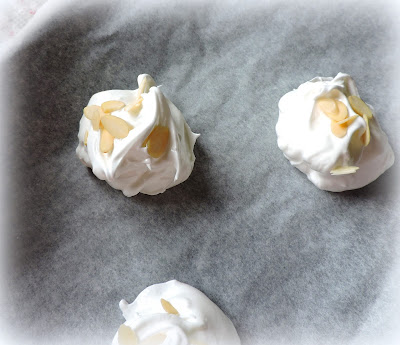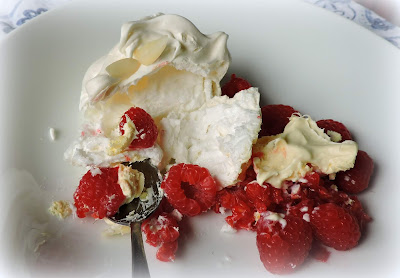Today I am going to teach you how to make perfect meringues. Making meringues is probably one of the things that can strike fear into even the most seasoned of cooks, and yes, they can be a bit tricky and a bit temperamental, but if you follow my tips and guidelines there is no reason why you can't be a great meringue maker. Crisp on the outside and as light as air!
Making meringues is not a process that can be rushed. Slow and steady always wins the race here. A few of my tips to help you get perfect meringues is to always use room temperature egg whites. Also use older eggs. Older, room temperature egg whites give you a lot more volume. Fresh egg whites just won't beat up the way you want them to. Make sure your eggs are at least a week old.
You also always want to make sure your beaters and bowls are scrupulously clean and grease free. That's why I always use a glass bowl. I always use an electric hand whisk. Its easier to control the speed with an electric hand whisk. I always start off at a low speed and then increase it incrementally . . .
So here you have my egg whites, in a clean bowl, at room temperature. I start on low and slowly beat, until they start to look opaque, and only then do I advance to a medium speed. Egg white contains chains of proteins that need to stretch slowly so they trap optimum air. If you beat them too fast, you risk snapping some of the chains permanently, making an unstable foam that’s likely to collapse when you add the sugar. Continue to whisk at medium speed, until they double in volume and resemble a white fluffy cloud. You don't want them to look dry.
Only after they reach this stage do you start to add the sugar. Again slow and steady wins the race. I use caster sugar, which is a fine grained granulated sugar. It makes for a much stabler mixture and creates crisp on the outside, soft on the inside meringues. If you don't have caster sugar, you can whirr regular granulated sugar in a food processor until it is finer. Add the sugar a bit at a time while you continue to beat the egg whites. I add it a spoonful at a time, which gives it a chance to melt into the egg whites.
Once you have all the sugar in you will have a white glossy billowy mixture like what you see in the above photo. Thick and glossy, but again, not dry.
The general rule of thumb is that you will use an equivalent weight of egg white and sugar. I like to use half caster and half icing/confectioners sugar. I fold the confectioners sugar into the whites, in thirds, making sure its well incorporated also. It should look roughly like this, with no lumps or bumps.
Its ready now to spoon onto a baking tray. Line your tray with baking parchment. The chemistry in meringues, which is means they are high in sugar, means that they want to stick to things, so I find that using a silicone baking sheet liner or baking parchment works the best. Make sure you leave plenty of space between them as they will puff up as they bake and you don't want them to end up touching each other. You want the air to be able to move freely around them. This is also when I sprinkle on any nuts if I am using them.
Bake them again, long and slow. At a low temperature. This allows the meringues to bake without over-colouring. They should be mostly white or at the very least a very light tan colour when they are done. Baking them at a higher temperature means that they will darken in colour and you won't get that nice crisp exterior with that soft mallow-like centre.
When done they will be as light and fluffy as air, with a beautifully crisp exterior. They might crack a bit, but that's okay. Its only when you make larger ones that they really crack. The smaller ones might not crack at all. If you tap them on the bottom they will sound hollow. They will be barely coloured at all.
Perfect meringues are beautifully light and crisp and wonderful on their own, but are especially lovely when served with fresh fruit and cream. Today I served them with some fresh Scottish raspberries and some of the clotted cream I had left from the other day . . .
These make a beautiful dessert, simple and very light . . . especially after a heavy meal. You are eating crisp sweet air . . .
You don't need to sweeten your berries or your cream . . . the meringues are sweet enough and will go beautifully with the tartness of the fruit and the creamy richness of the cream. This is pure and simple . . . a dessert confection created in heaven. Bliss, pure and utter bliss . . .
*Perfect Meringues*
Makes 16
These are perfect. Billowy and sweet.
4 large free range egg whites, at room temperature
115g caster sugar (9 1/2 TBS)
115g icing sugar, sifted (14 TBS)
Preheat your oven to 100*C/200*F/gas mark 1/4. Line several baking sheets with baking parchment paper. Set aside.
Put the egg whites into a large scrupulously clean GLASS bowl. Beat on medium speed with an electric whisk until the mixture resembles a fluffy cloud. Increase the temperature and start adding the caster sugar 1 spoonful at a time, beating 3 to 4 seconds after each addition. The mixture should be thick and glossy when done. (Note, if you don't add the sugar slowly, your meringue will weep later on, and we don't want that.)
Sift 1/3 of the icing sugar over top and fold in with a metal spoon. Repeat until all of the icing sugar has been folded in. You should have a thick smooth, billowy almost snow-drift type of mixture now.
Using two spoons dollop the mixture onto the prepared baking sheets in oval shapes, or simply just dollop into rounds.
Bake in the preheated oven for 1 1/2 to 1 3/4 hours. They should sound crisp when tapped on the bottom, and will be a very pale tan colour. Cool on wire racks. You can store these in an airtight tin for up to two weeks, or freeze for up to a month.
Beautiful put together in pairs with whipped cream.
I really hope you will try making some meringues soon. I am fairly confident that if you use my hints tips and method, you are sure to have success with them! If you do, be sure to come back and let me know. Even if you don't. Perhaps I can help. In any case, Bon Appetit!




















0 komentar